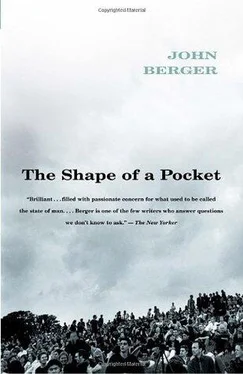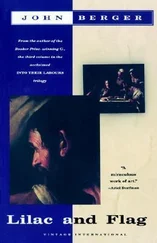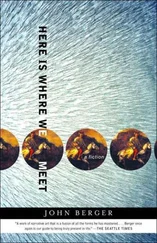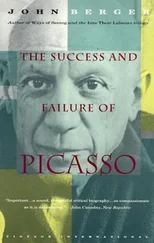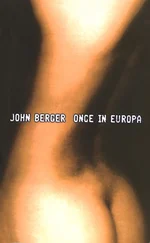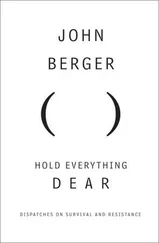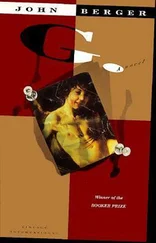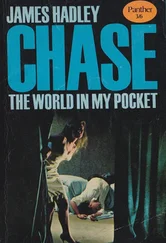John Berger
The Shape of a Pocket
The ceiling of the bedroom is painted a faded sky blue. There are two large rusty hooks screwed into the beams and from these, long ago, the farmer hung his smoked sausages and hams. This is the room in which I’m writing. Outside the window are old plum trees, the fruit now turning raven blue, and beyond them the nearest hill which forms the first step to the mountains.
Early this morning, when I was still in bed, a swallow flew in, circled the room, saw its error and flew out through the window past the plum trees to alight on the telephone wire. I relate this small incident because it seems to me to have something to do with Pentti Sammallahti’s photographs. They too, like the swallow, are aberrant.
I have had some of his photographs in the house now for two years. I often take them out of their folder to show to friends who pass. They usually gasp at first, and then peer closer, smiling. They look at the places shown for a longer time than is usual with a photograph. Perhaps they ask whether I know the photographer, Pentti Sammallahti, personally? Or they ask what part of Russia were they taken in? In what year? They never try to put their evident pleasure into words, for it is a secret one. They simply look closer and remember. What?
* * *
In each of these pictures there is at least one dog. That’s clear and it might be no more than a gimmick. Yet in fact the dogs offer a key for opening a door. No, a gate — for here everything is outside, outside and beyond.
I notice also in each photograph the special light, the light determined by the time of day or the season of the year. It is, invariably, the light in which figures hunt — for animals, forgotten names, a path leading home, a new day, sleep, the next lorry, spring. A light in which there is no permanence, a light of nothing longer than a glimpse. This too is a key to opening the gate.
The photos were taken with a panoramic camera, such as is normally used for making wide-section geological surveys. Here the wide-section is important, not, I think, for aesthetic reasons but, once again, for scientific, observational ones. A lens with a narrower focus would not have found what I now see, and so it would have remained invisible. What do I now see?
We live our daily lives in a constant exchange with the set of daily appearances surrounding us — often they are very familiar, sometimes they are unexpected and new, but always they confirm us in our lives. They do so even when they are threatening: the sight of a house burning, for example, or a man approaching us with a knife between his teeth, still reminds us (urgently) of our life and its importance. What we habitually see confirms us.
Yet it can happen, suddenly, unexpectedly, and most frequently in the half-light-of-glimpses, that we catch sight of another visible order which intersects with ours and has nothing to do with it.
The speed of a cinema film is 25 frames per second. God knows how many frames per second flicker past in our daily perception. But it is as if, at the brief moments I’m talking about, suddenly and disconcertingly we see between two frames. We come upon a part of the visible which wasn’t destined for us. Perhaps it was destined for night-birds, reindeer, ferrets, eels, whales …
Our customary visible order is not the only one: it coexists with other orders. Stories of fairies, sprites, ogres were a human attempt to come to terms with this coexistence. Hunters are continually aware of it and so can read signs we do not see. Children feel it intuitively, because they have the habit of hiding behind things. There they discover the interstices between different sets of the visible.
Dogs, with their running legs, sharp noses and developed memory for sounds, are the natural frontier experts of these interstices. Their eyes, whose message often confuses us for it is urgent and mute, are attuned both to the human order and to other visible orders. Perhaps this is why, on so many occasions and for different reasons, we train dogs as guides.
Probably it was a dog who led the great Finnish photographer to the moment and place for the taking of these pictures. In each one the human order, still in sight, is nevertheless no longer central and is slipping away. The interstices are open.
The result is unsettling: there is more solitude, more pain, more dereliction. At the same time, there is an expectancy which I have not experienced since childhood, since I talked to dogs, listened to their secrets and kept them to myself.

2 Steps Towards a Small Theory of the Visible (for Yves)
When I say the first line of the Lord’s Prayer: ‘Our father who art in heaven …’ I imagine this heaven as invisible, unenterable but intimately close. There is nothing baroque about it, no swirling infinite space or stunning foreshortening. To find it — if one had the grace — it would only be necessary to lift up something as small and as at hand as a pebble or a salt-cellar on the table. Perhaps Cellini knew this.
‘Thy kingdom come …’ The difference is infinite between heaven and earth, yet the distance is minimal. Simone Weil wrote concerning this sentence: ‘Here our desire pierces through time to find eternity behind it and this happens when we know how to turn whatever happens, no matter what it is, into an object of desire.’
Her words might also be a prescription for the art of painting.
Today images abound everywhere. Never has so much been depicted and watched. We have glimpses at any moment of what things look like on the other side of the planet, or the other side of the moon. Appearances registered, and transmitted with lightning speed.
Yet with this, something has innocently changed. They used to be called physical appearances because they belonged to solid bodies. Now appearances are volatile. Technological innovation has made it easy to separate the apparent from the existent. And this is precisely what the present system’s mythology continually needs to exploit. It turns appearances into refractions, like mirages: refractions not of light but of appetite, in fact a single appetite, the appetite for more.
Consequently — and oddly, considering the physical implications of the notion of appetite — the existent, the body, disappears. We live within a spectacle of empty clothes and unworn masks.
Consider any newsreader on any television channel in any country. These speakers are the mechanical epitome of the disembodied. It took the system many years to invent them and to teach them to talk as they do.
No bodies and no Necessity — for Necessity is the condition of the existent. It is what makes reality real. And the system’s mythology requires only the not-yet-real, the virtual, the next purchase. This produces in the spectator, not, as claimed, a sense of freedom (the so-called freedom of choice) but a profound isolation.
Until recently, history, all the accounts people gave of their lives, all proverbs, fables, parables, confronted the same thing: the everlasting, fearsome, and occasionally beautiful, struggle of living with Necessity, which is the enigma of existence — that which followed from the Creation, and which subsequently has always continued to sharpen the human spirit. Necessity produces both tragedy and comedy. It is what you kiss or bang your head against.
Today, in the system’s spectacle, it exists no more. Consequently no experience is communicated. All that is left to share is the spectacle, the game that nobody plays and everybody can watch. As has never happened before, people have to try to place their own existence and their own pains single-handed in the vast arena of time and the universe.
Читать дальше
